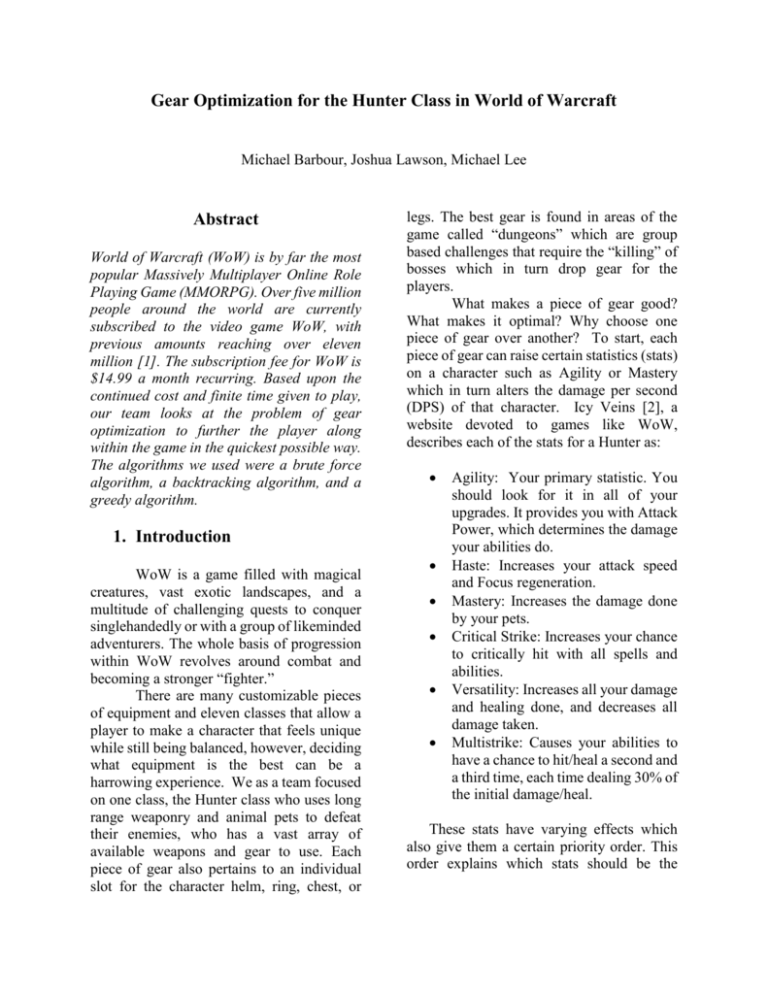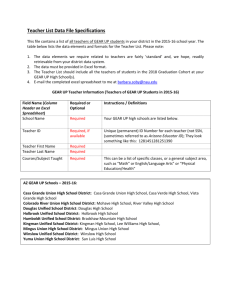paper - People Server at UNCW
advertisement

Gear Optimization for the Hunter Class in World of Warcraft
Michael Barbour, Joshua Lawson, Michael Lee
Abstract
World of Warcraft (WoW) is by far the most
popular Massively Multiplayer Online Role
Playing Game (MMORPG). Over five million
people around the world are currently
subscribed to the video game WoW, with
previous amounts reaching over eleven
million [1]. The subscription fee for WoW is
$14.99 a month recurring. Based upon the
continued cost and finite time given to play,
our team looks at the problem of gear
optimization to further the player along
within the game in the quickest possible way.
The algorithms we used were a brute force
algorithm, a backtracking algorithm, and a
greedy algorithm.
legs. The best gear is found in areas of the
game called “dungeons” which are group
based challenges that require the “killing” of
bosses which in turn drop gear for the
players.
What makes a piece of gear good?
What makes it optimal? Why choose one
piece of gear over another? To start, each
piece of gear can raise certain statistics (stats)
on a character such as Agility or Mastery
which in turn alters the damage per second
(DPS) of that character. Icy Veins [2], a
website devoted to games like WoW,
describes each of the stats for a Hunter as:
1. Introduction
WoW is a game filled with magical
creatures, vast exotic landscapes, and a
multitude of challenging quests to conquer
singlehandedly or with a group of likeminded
adventurers. The whole basis of progression
within WoW revolves around combat and
becoming a stronger “fighter.”
There are many customizable pieces
of equipment and eleven classes that allow a
player to make a character that feels unique
while still being balanced, however, deciding
what equipment is the best can be a
harrowing experience. We as a team focused
on one class, the Hunter class who uses long
range weaponry and animal pets to defeat
their enemies, who has a vast array of
available weapons and gear to use. Each
piece of gear also pertains to an individual
slot for the character helm, ring, chest, or
Agility: Your primary statistic. You
should look for it in all of your
upgrades. It provides you with Attack
Power, which determines the damage
your abilities do.
Haste: Increases your attack speed
and Focus regeneration.
Mastery: Increases the damage done
by your pets.
Critical Strike: Increases your chance
to critically hit with all spells and
abilities.
Versatility: Increases all your damage
and healing done, and decreases all
damage taken.
Multistrike: Causes your abilities to
have a chance to hit/heal a second and
a third time, each time dealing 30% of
the initial damage/heal.
These stats have varying effects which
also give them a certain priority order. This
order explains which stats should be the
primary focus. Icy Veins also describes this
on their page as:
The stat priority for a Beast Mastery Hunter
is:
1.
2.
3.
4.
5.
6.
7.
Agility;
Weapon DPS;
Mastery;
Haste;
Multistrike;
Versatility;
Critical Strike.
Using these stats we can determine which
pieces of gear become more beneficial than
others. Another website that was trying to
solve the same problem called Ask Mr. Robot
also had an equation that we took into
account that ranked the stats based on
maximizing DPS [3].
To correctly test these choices we used
the program SimulationCraft (SimC) [4].
SimC allowed for us to put specific gear sets
into the system to test the DPS based up
organized combat rotations. An organized
combat rotation takes human interaction out
of the equation and gives an optimal DPS
reading as if all of the combat skills are used
with perfect timing.
2. Problem Statement
The idea became how to correctly choose
gear for your video game character based
upon stats and gear slot that would maximize
DPS. To allow for data collection under time
constraints we chose to use the seven gear
slots that had items with the largest stats
associated.
Helm
Chest
Shoulder
Gloves
Legs
Boots
Weapon
We then selected six pieces of gear for
each slot, except the weapon where we only
selected five, based within a specific level
range. This allowed for a specific pool to
choose from and for us to gauge the DPS
change.
Our problem then became a modified 0/1
Knapsack problem [5]. We had the item slots,
which become our bag, the DPS change per
piece of gear became our value, and the
probability that a piece of gear would be
dropped over a one hundred period became
the weight. The 0/1 aspect was dictated by the
fact that only one item per gear slot could be
used. No more than one helm, one weapon
etc. could be taken.
3. Formal Statement
Our goal is to maximize damage per
second (represented by the variable vi)
subject to the probability of acquiring a
specific item over a one hundred day time
period (represented by wi.).
Maximize:
Subject to:
wi W
iT
And:
* T = all possible gear subsets 𝑇⊆{1,….,𝑛}
* Xi = Each item {1,….,}
* Vi = Value of Xi
* Wi (Weight or limiting factor) of Xi
4.00%
3.50%
3.00%
2.50%
2.00%
1.50%
1.00%
0.50%
0.00%
Any Probability
Above 80%
Above 85%
0
1600
3200
4800
6400
8000
9600
11200
12800
14400
16000
17600
19200
20800
22400
24000
25600
27200
28800
30400
32000
33600
35200
36800
38400
Percent of Total Sets
Brute Force Distribution
Damage Value (increments of 400)
Figure 3.1 Distribution of gear subsets based on probability.
4. Algorithms
Tackling this problem came down to
three different approaches we chose to use
based upon the fundamental knapsack
concept. We implemented a Brute Force
Enumeration algorithm, an Adaptive
Backtracking algorithm, and a Greedy
algorithm.
A. Brute Force Enumeration
The Brute Force algorithm solves the
knapsack problem by trying every possible
subset of items and calculating the drop
chance of that set. If the weight (drop
chance) stays within the bounds, and the
subset provides more value (DPS) then the
piece is kept and the next set is tried. The
result is an algorithm with exponential
complexity O(an) and over two hundred
thousand different subsets.
The algorithm accomplishes this by
calling a set generator that generates an array
of 7 integers, each one ranging from 0 to 6
except for the first integer which only ranges
from 0 to 5. Each of these sets are then put
into the damage calculator which finds both
the drop chance and the probability for that
set in constant time O(1). The values are then
compared to the best of all previous sets and
saves the value as the new best if it stays
within the bounds and provides a higher
value.
The biggest benefit of running a brute
force algorithm is that it will find the
definitive best solution.
The biggest
drawback is the run time can be prohibitive
as the program scales very poorly.
Figure 3.1 above demonstrates the
distribution of potential gear sets. The x axis
of that graph is comprised of grading for each
damage value incremented in steps of 400.
The y axis displays the percent of the total
number of sets that fit within that damage
range. Each of the three different colors
represent the gear set with a different weight
constraint. The yellow corresponds with all
possible sets and is the unbounded solution
containing 233,280 different subsets, the
orange corresponds with a greater than 80%
drop chance and contains 106,497 different
subsets, and the red with an 85% drop chance
and contains 23888 different subsets.
The multimodal distribution is
associated with the jump in value by taking a
piece of gear to fill an otherwise unoccupied
slot. Leaving a slot empty means that either
an additional piece cannot be taken and still
stay within the weight constraints, or that the
gear improvement provided by another piece
with a higher weight outweighs the
improvement of taking another piece
altogether. The optimal gear set while the
constraint remains unbounded fills every gear
slot as having gear strongly increases damage
output, the 80% bound fills all slots except
for the foot piece, and the 85% bound fills all
gear slots except for the foot and hand pieces.
B. Backtracking
Backtracking
algorithms
use
constraints to find optimal solutions by trying
one possible “answer” and then backtracking
if that solution fails to meet the optimal
solution. Using this, we have made an
adaptive backtracking algorithm that splits
the problem into a collection of smaller
problems. Each gear slot functions as a
specific branch of a tree. The algorithm will
select a subset of gear that includes one piece
for each slot and actively backtracks from the
piece of gear with the lowest weight to find
the optimal set. It does this search only within
the specific gear slot. Doing this cuts down
runtime so the algorithm will not have to
continuously go back to that gear slot to see
if there is a more optimal choice.
The constraints given for the
backtracking algorithm were set to match the
given constraints for the total Knapsack
problem. The algorithm first uses the total
value as a basis to find the gear set that is
supposedly optimal, then the algorithm will
find the set with the highest drop probability
starting from the previously found gear set.
Since all of the algorithms use the same
equations to define values, the backtracking
algorithm will find the set with the highest
value that is within the constraint limit for
weight.
To find the gear set with the highest
drop percentage the backtracking algorithm
will go back to the first gear slot that is not
optimal and change the piece of gear, then it
will move to the next until there are no more
it needs to change for that cycle. If that cycle
fails, then the algorithm will go through the
gear slot that was the last to be changed and
change the piece until the drop percentage
requirement was met or until it has exhausted
all usable pieces of gear. We did constraint
limits of 0%, 75%, 80%, 85%, and 100%. If
the latter occurs then the algorithm will
“backtrack” to the piece next on this list that
has the lowest weight and perform the same
action, while leaving the previous gear piece
on the next possible gear piece for that slot.
When a proper gear piece is found in that slot,
the piece with the highest value to weight
ratio, the algorithm locks that piece in place
so that it cannot be changed again.
The implementation of this algorithm
changes the runtime of what would be
considered ideal for backtracking as the
approach could be considered naive.
Depending on how the data set is supplied,
this algorithm has the ability to perform
similar to an exhaustive search algorithm. We
determined that the worst case runtime of this
algorithm would be O(an) where a is the
number of slots in the gear set, and n is the
number of items available in that specific
slot.
C. Greedy
Lastly, the Greedy algorithm we designed
took a straightforward approach to solving
our problem by simply choosing the items
that had the highest value or highest weight.
This naïve way of tackling the problem
showed that the ease of use and simplicity
were quite a hindrance once the constraints
were included within the algorithm.
The algorithm starts by taking the
data set, all of the gear options, and creating
a nested array with one item being a row and
the four columns reading as; the name of the
item, the slot in which the item fits, the items
weight, and the items value. The simple sort
then initiated will put the items in descending
order based upon weight, value, or ratio.
The algorithm then iterates through
the newly formed array and “grabs” items in
order of occurrence. These items are then
placed into a new array which will eventually
make up the chosen gear set. On each “grab”
the algorithm checks to see whether an item
of the same type already exists within the
array. If there is not, the item is added to the
list, and if there is the item is skipped over
and the algorithm “grabs” the next item.
Once the constraint limit is hit the
algorithm will stop and no longer continue
looking for any items. What we discovered
was that once the constraint went above the
optimal gear set there wasn’t even remotely
close to an optimal solution. This is a
drawback of trying to solve a 0/1 knapsack
problem with a greedy algorithm. Without
constraints the optimal answer is found in a
straightforward fashion but that is the only
time it happens.
The complexity can be determined as
O(n log n) + O(nm). The O(n log n) from the
initial sort and then O(nm) where n is the
number of pieces in the solution and m is the
total number of items.
5. Conclusion
The optimal set without considering drop
chance consists of Black Iron Sniper Rifle,
Lavalink Stompers, Morningscale Gauntlet,
Rockhide Casque, Morningscale Leggings,
Lavalink Spaulders, and Streamslither
Chestguard. The optimal set considering an
80% lower bound consists of the Black Iron
Sniper Rifle, Morningscale Gauntlet,
Rockhide Casque, Morningscale Leggings,
Lavalink Spaulders, and Streamslither
Chestguard. The optimal set using an 85%
lower bound consists of the Black Iron Sniper
Rifle, Rockhide Casque, Morningscale
Leggings,
Lavalink
Spaulders,
and
Streamslither Chestguard.
The only difference between each of
these gear sets is the subtraction of one piece,
the boots at an 80% drop chance and the
boots and gloves at an 85% drop chance.
From this it is possible to see many failings
of the experiment itself. Due to how similar
the weights are and how different the value of
each piece is, it works optimally to simply
drop a piece entirely than to give up on one
of the more valuable pieces. The solution to
optimizing hunter damage relies on depth,
focusing on one particular piece (specifically
more valuable pieces), rather than breadth,
getting a piece for every slot.
None of these algorithms preform
perfectly but none are without value. While
the brute force enumeration succeeds in
checking each piece, it runs into issues when
it comes to larger data sets. The backtracking
approaches can also end up being incredibly
complex and performs poorly when used on
larger data sets or without given a clear exit
condition. The greedy algorithm fails to find
the best results for bounded problems but has
a quick run time, working very well to find a
decent optimal solution.
6. Future Work
To expand upon our problem as it is
right now there could possibly be ways to
rework the greedy algorithm by infusing it
with the backtracking algorithm. Allowing
the greedy algorithm to roughly estimate the
depth of a specific path, and backtracking to
find another path once it fails. Or potentially
changing the greedy algorithm so that it could
accept a seemingly suboptimal option
randomly in order to potentially approach an
unforeseen maximum.
To go beyond what has been laid out
here would be to add in all of the other classes
in WoW and all of the items available within
the game. This would add a tremendous
amount of data but allow us to give specific
gear sets for each level in the game for all
players. Besides WoW, there are a multitude
of video games that run according to the same
general idea and would allow for us to
transfer the algorithms just by changing the
initial data set and value calculation.
Given enough time our algorithms could
be changed to apply to all knapsack
problems. Anything that would deal with this
specific type of problem could then become
grounds for research and testing. Freight
shipping, manufacturing storage, and
transportation services.
7. References
1. Ahuja, Amrita Osako, Mary. Nov. 3,
2015. Activision Blizzard Third Quarter
Financial
Results
2015.
http://investor.activision.com/results.cfm
(Nov 3, 2015)
2. Vlad. Aug. 14, 2015. Beast Mastery
Hunter DPS Stat Priority (WoD 6.2.2).
http://www.icy-veins.com/wow/beastmastery-hunter-pve-dps-stat-priority
(October 14, 2015)
3. Coley, Peter. Nov. 16, 2015. Ask Mr.
Robot
Gear
Optimizer.
http://www.askmrrobot.com/wow/player
(October 11, 2015)
4. Camille, Serge. Dec. 1, 2015.
SimulationCraft.
http://simulationcraft.org/ (October 20,
2015)
5. Tian, Y. , Lv, J. and Zheng, L. (2013) An
Algorithm of 0-1 Knapsack Problem Based
on Economic Model. Journal of Applied
Mathematics and Physics, 1, 31-35.
doi: 10.4236/jamp.2013.14006.







